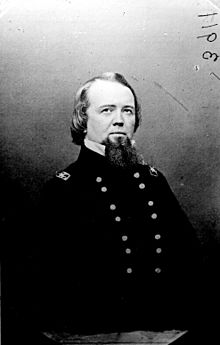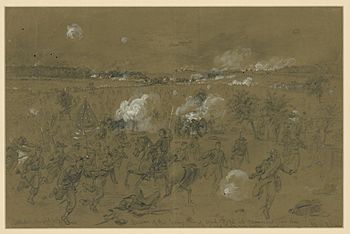John Pope (general) facts for kids
Quick facts for kids
John Pope
|
|
|---|---|

Brig. Gen. John Pope
|
|
| Born | March 16, 1822 Louisville, Kentucky |
| Died | September 23, 1892 (aged 70) Ohio Soldiers and Sailors Home near Sandusky, Ohio |
| Place of burial | |
| Allegiance | |
| Service/ |
United States Army Union Army |
| Years of service | 1842–1886 |
| Rank | |
| Commands held | Army of the Mississippi Army of Virginia Department of the Northwest Department of the Missouri Military Division of the Pacific |
| Battles/wars | Mexican–American War Apache Wars |
John Pope (born March 16, 1822 – died September 23, 1892) was an officer in the United States Army. He became a general for the Union Army during the American Civil War.
Pope first served in the western part of the war. But he is most famous for a big loss at the Second Battle of Bull Run (also called Second Manassas) in the eastern part of the war.
He graduated from the United States Military Academy in 1842. He fought in the Mexican–American War. Later, he worked as an engineer and surveyor in places like Florida and New Mexico. Before the Civil War, he spent many years mapping possible routes for the first transcontinental railroad.
When the Civil War began, Pope quickly became a Union general. He had early success against Confederate forces in Missouri. He also led a successful campaign to capture Island No. 10 on the Mississippi River. Because of these wins, President Abraham Lincoln brought him to the East. There, he led the new Army of Virginia.
Pope often upset his officers and soldiers. He publicly said their past efforts were not as good as his Western command. He started an attack against General Robert E. Lee's Confederate army. But he fell into a trap set by Major General Stonewall Jackson. At Second Bull Run, Pope focused on attacking Jackson. However, another Confederate group, led by Major General James Longstreet, attacked his side. This caused his army to be completely defeated.
After this defeat, Pope was sent far away to Minnesota. There, he commanded U.S. forces during the Dakota War of 1862. In 1865, he was put in charge of the Department of the Missouri. He was an active commander during the Reconstruction period in Atlanta. For the rest of his military career, he fought in the Indian Wars, especially against the Apache and Sioux tribes.
Contents
Early Life and Military Career
John Pope was born in Louisville, Kentucky. His father, Nathaniel Pope, was an important judge in early Illinois Territory. Nathaniel was also a friend of lawyer Abraham Lincoln.
Pope finished his studies at the United States Military Academy in 1842. He was 17th in his class of 56 students. He became a second lieutenant in the Corps of Topographical Engineers. These engineers specialized in mapping and surveying.
He worked in Florida and helped map the border between the United States and Canada. During the Mexican–American War, he fought under General Zachary Taylor. He took part in the Battle of Monterrey and the Battle of Buena Vista. For his bravery, he was promoted to first lieutenant and then captain. After the war, Pope worked as a surveyor in Minnesota. In 1850, he proved that the Red River could be used by boats. From 1851 to 1853, he was the chief engineer for the Department of New Mexico. He spent the years before the Civil War mapping a route for the Pacific Railroad.
Civil War Service
When Abraham Lincoln became president, Pope was one of four officers who helped escort him to Washington, D.C.. Pope offered to be Lincoln's helper. But on June 14, 1861, he was made a brigadier general. He was sent to Illinois to recruit volunteer soldiers.
Early Successes in the West
In the Department of the West, Pope was under Major General John C. Frémont. In July, Pope took command of the District of North and Central Missouri. He was in charge of a part of the Mississippi River. Pope and Frémont did not get along well. Pope tried to get Frémont removed from command.
Pope eventually forced the Confederates under Sterling Price to retreat. He captured 1,200 prisoners in a small fight at Blackwater, Missouri, on December 18. Pope was known for boasting early in the war. He got a lot of attention for this small victory. This made Frémont's replacement, Major General Henry W. Halleck, notice him.
Halleck put Pope in charge of the Army of the Mississippi on February 23, 1862. With 25,000 soldiers, Pope was told to clear Confederate blockades on the Mississippi River. He surprised the Confederates by marching on New Madrid, Missouri. He captured it on March 14. Then, he planned a campaign to capture Island No. 10. This was a very strong fort with 12,000 soldiers and 58 cannons. Pope's engineers dug a channel to go around the island. With help from Captain Andrew H. Foote's gunboats, Pope landed his soldiers on the other side. This trapped the defenders. The soldiers on the island surrendered on April 7, 1862. This allowed Union boats to use the Mississippi River all the way to Memphis.
Pope's great work on the Mississippi River earned him a promotion to major general on March 21, 1862. During the Siege of Corinth, he led the left side of Halleck's army. But soon, Lincoln called him to the East. After Major General George B. McClellan's Peninsula Campaign failed, Pope was chosen to lead the Army of Virginia. This army was made up of different groups of soldiers from the Shenandoah Valley and Northern Virginia. This promotion made Frémont very angry, and he resigned.
Challenges in the East
Pope arrived with a very confident attitude. This offended the soldiers in his new Eastern command. On July 14, 1862, he sent a surprising message to his new army. He basically told them that he came from the West, where they always made the enemy run away. He said they should always attack and not worry about retreating. This message made many soldiers dislike him from the start.

Despite his bold words, and even with soldiers from McClellan's Army of the Potomac joining him (making his army 70,000 strong), Pope's aggressive plans were too much for his skills. Especially since he was now facing Confederate General Robert E. Lee. Lee realized Pope was unsure of himself. So, Lee split his smaller army (55,000 men). He sent Major General Stonewall Jackson with 24,000 men to Cedar Mountain. There, Jackson defeated Pope's officer, Nathaniel Banks.
As Lee moved towards Pope with the rest of his army, Jackson swung around to the north. He captured Pope's main supply base at Manassas Station. Pope was confused and could not find the main Confederate army. He walked into a trap at the Second Battle of Bull Run. His soldiers fought off a combined attack by Jackson and Lee on August 29, 1862. But the next day, Major General Fitz John Porter reluctantly followed Pope's orders to attack Jackson. This exposed his side, and the entire Union army's side. Major General James Longstreet launched a surprise attack from the side. The Union Army was badly defeated and forced to retreat. Pope made himself even more unpopular by blaming his defeat on Major General Porter. Porter was later found guilty by a military court and disgraced.
Pope was removed from command on September 12, 1862. His army was combined with the Army of the Potomac, now led by McClellan again. Pope spent the rest of the war in the Department of the Northwest in Minnesota. There, he dealt with the Dakota War of 1862. His time fighting in the West helped his career. He was assigned to command the Military Division of the Missouri on January 30, 1865. He also received a special promotion to major general in the regular army on March 13, 1865, for his service at Island No. 10.
After the War
In April 1867, Pope was made governor of the Reconstruction Third Military District. His main office was in Atlanta. He issued orders that allowed African Americans to serve on juries. He also ordered Mayor James Williams to stay in office longer. He postponed elections and banned city advertisements in newspapers that did not support Reconstruction. President Andrew Johnson removed him from this command on December 28, 1867. George G. Meade took his place. After this, Pope was put in charge of the Department of the Lakes (in Detroit, Michigan) from January 13, 1868, to April 30, 1870.
Pope returned to the West as commander of the Department of the Missouri. This was the second-largest military command in the country. He held this position through 1883. He served well in the Apache Wars. This included the Red River War, which moved Southern Plains tribes to reservations in Oklahoma. General Pope made some political enemies in Washington. He suggested that the military should manage the reservation system instead of the Indian Bureau, which he thought was corrupt. He also caused debate by asking for better and kinder treatment of Native Americans.
Pope was promoted to major general in the Regular Army in 1882. In 1883, he was assigned to command the Military Division of the Pacific. He served there until he retired.
Later Life and Legacy
Pope retired as a major general on March 16, 1886. His wife, Clara Pope, died two years later. His memories were published in a newspaper called the National Tribune between February 1887 and March 1891. General Pope died on September 23, 1892, at the Ohio Soldiers' Home near Sandusky, Ohio. He is buried next to his wife in Bellefontaine Cemetery, St. Louis, Missouri.
See also
 In Spanish: John Pope para niños
In Spanish: John Pope para niños
- List of American Civil War generals (Union)
- The Court-martial of Fitz John Porter


